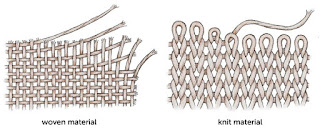Differences Between Knitted And Woven Fabrics - The following various important differences between knitted and woven fabrics
movement, mobility and elasticity
knitted fabrics tend to mold and fit easily to body shapes and to move easily with body movement. woven fabrics are usually rigid (unless made with stretch yarns), do not mold to body shape, and tend to resist body movement. warp knitted tend to be more rigid than weft knits, but not quite as rigid as woven fabrics. because of this quality , is alwasys made from knit contructions, never from woven fabric.
Recovery from wrinkling
Knitted fabrics recover from wrinkling are readily than
woven fabric, however, take a less sharp crease than woven. The wrinkle-recovery
property of knits is what makes them so suitable for traveling
Insulation and warm
Bulky knit fabric provide excellent insulation in still air,
but because of the open structure of knitted fabrics, they provide poor
insulation in wind. Tightly woven fabrics provide a high degree of wind
resistance. Thus, sweaters are good clothing insulators indoors, but when worn
outdoors in wind conditions, they need to be covered by a tightly woven wind
resistant jacket or parka
Problem
Knit fabrics, particularly loosely knitted construction,
tend to stretch out of shape and or snag on sharp articles (e.g. broken
fingernail) more than woven fabrics. Knit fabrics garments should not be hung
on hangers for long periods, but should be folded and stored. Knit fabrics tend
to stretch out when being spread or laid out for cutting during the garment
manufacturing process.






